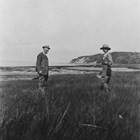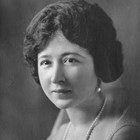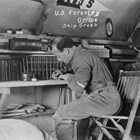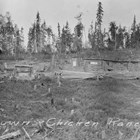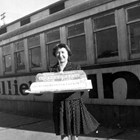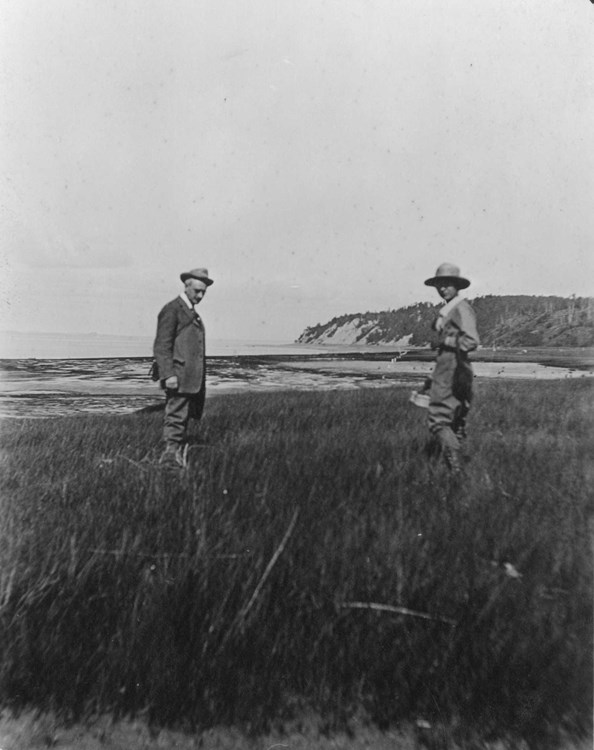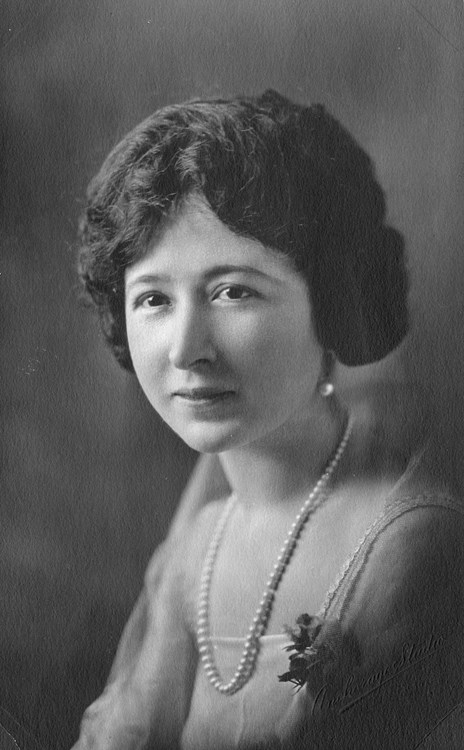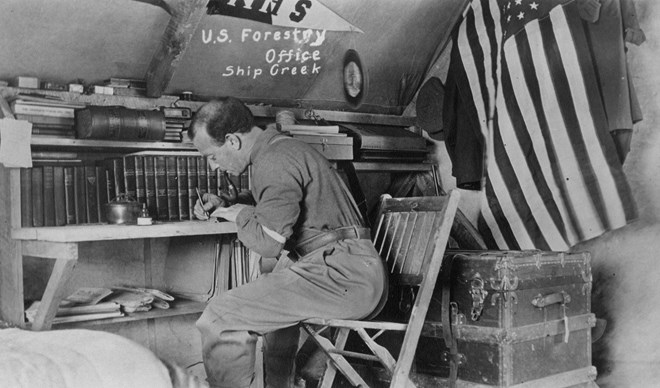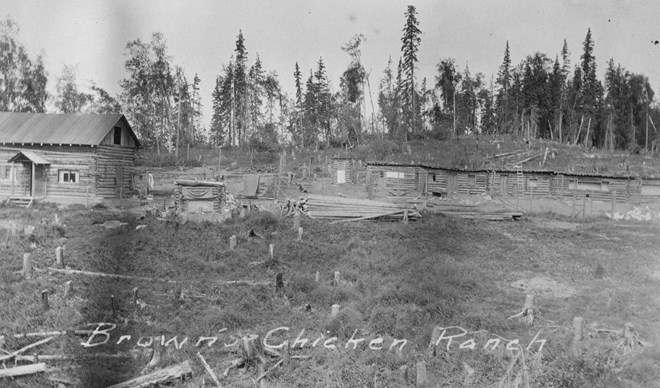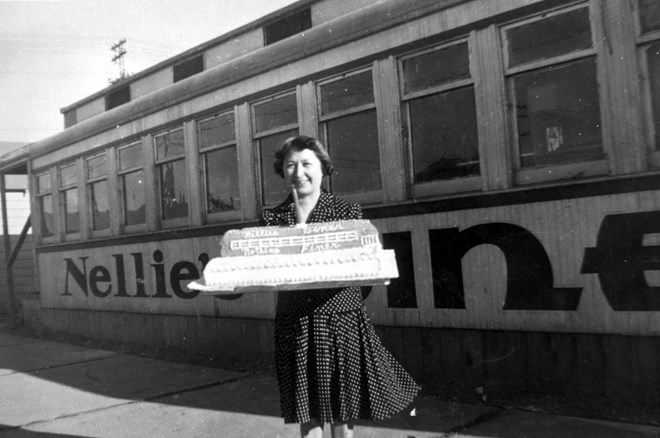Brown, John Matthew "Jack" and Nellie Shepard
Anchorage Pioneers
John “Jack” Brown and Nellie Shepard Brown came to Ship Creek, which later became Anchorage, in 1912. They lived in and around Anchorage for the remainder of their lives, and became celebrated as the city’s pioneering residents.
Early Years
John Matthew Brown, universally known as “Jack,” was born on June 5, 1878, in Glasgow, Scotland. He immigrated to Canada and worked herding cattle in the Calgary area. He then worked on railroad construction gangs as a laborer in both Canada and Montana. In 1905, he found a job with one of the railroad survey crews in Montana.
Brown immigrated to the United States sometime between 1903 and 1906. In Mary J. Barry’s biography, Jack and Nellie Brown: Pioneer Settlers of Anchorage, Barry states that Brown came to Alaska in 1906.1 The U.S. 1930 Census indicates that he arrived in the United States in 1903,2 but the 1920 U.S. Census gives 1905 as the year of arrival.3 After the Chugach National Forest was established in 1907, Brown became a forest guard and assistant forest ranger, working for the U.S. Forest Service at various times from 1910 to 1917. In 1910, Brown was stationed at the mining community of Sunrise on Turnagain Arm. While in Sunrise he applied for U.S. citizenship; he received his naturalization certificate in June 1916.4
In 1911, Brown and another Forest Service employee, Keith McCullough, were sent to survey and inspect the upper Kenai Peninsula and mark the boundaries of Chugach National Forest. They traveled by dog team from Seward to the western coast of the Kenai Peninsula, and south as far as Tustumena Lake surveying the boundaries. Part of the time they traveled by raft. Brown noted that he and McCullough ate the same rations as the dogs – fish.5
Mary Barry’s account has John "Jack" Brown meeting Nellie Edythe Shepard in Cordova in 1911. However, the 1910 U.S. Census shows him as a lodger in Cordova, with the adjacent dwelling being Nellie’s parents’ home.6 However they met, they married on May 1, 1912 when Nellie was twenty-one and just before his thirty-fourth birthday. Nellie was born in April 1891, the first of eight children born to Anna Ehutch, a young Eyak Indian woman who was born in the Cordova area, and William John “Jack” Shepard, who was born in 1863 on a farm in Pennsylvania. Shepard left the farm to move west and had come to Alaska as a prospector in 1886, settling at Eyak, later renamed Cordova. He had mining claims in the Eyak area and also was involved with the developing fish canning business. In 1900 he became postmaster at Orca, a post he held until 1909.7
Many of the Shepard children attended the Chemawa Indian School in Chemawa, Oregon. Nellie entered the school at the age of twelve, in 1902. She stayed there for the next eight years until April 1910, when her father, William Shepard, requested permission for her to return to Cordova. Shepard gave Superintendent Edwin L. Chalcraft three reasons for requesting Nellie’s return: first, his wife, Anna, was not well, and he needed one of his three daughters to help her. Second, the Shepards had become alarmed because Nellie had been losing weight. And finally, her father “understood that she had a fondness for boys and we would like her where we could advise and help her select her associates.”8
After their 1912 marriage, John "Jack" and Nellie Brown almost immediately traveled by boat to upper Cook Inlet and Jack’s new post as a forest ranger headquartered at Ship Creek. While on the way, the Novarupta volcano erupted, spreading volcanic dust throughout the area. According to Barry, Nellie thriftily collected volcanic ash to be used as cleaning abrasive. The Browns initially lived in a tent that also served as the Forest Service office. They shortly moved into a 10-foot x 14-foot cabin that had been built by J.D. “Bud” Whitney and his wife, Daisy, early homesteaders at Ship Creek. Later Nellie would remember that Ship Creek when they arrived “was very peaceful and quiet. Nothing unusual happened.” They collected their mail at a road house near Eagle River along the Iditarod Trail, and traveled to Knik to buy supplies. Local fish and game, berries and greens supplemented their store bought supplies. Nellie remembered being a good hunter. They made their furniture from grocery crates. The following year, 1913, they built their own three-room cabin on the Ship Creek flats.
Permanent Settlers at Ship Creek
Their bucolic surroundings began changing in the summer of 1914 when survey parties for a proposed federal railroad landed at Ship Creek and scattered throughout southcentral Alaska. The survey parties found a handful of settlers and buildings in the area, but it was relatively undeveloped. John "Jack" Brown lived near the mouth of Ship Creek with his wife, Nellie. Forester Keith McCullouch also had a cabin at Ship Creek. The Whitneys were legitimately homesteading toward the upper end of Ship Creek. Thomas Jeter had settled in a small cabin just under Government Hill near the mouth of Ship Creek in 1912. Jeter was really a squatter, as he had not filed a homestead application for the parcel of land he had claimed. Nearby, Hitchkock and Weiremen had built a cabin in 1906 with the intention of operating a saloon and roadhouse there. George W. Palmer, who had started the trading post at Knik, had a warehouse along the shoreline, about three miles north of Ship Creek.9
Brown resigned from the U.S. Forest Service in September 1914, bought two small boats, and began a freighting business. In 1915, President Woodrow Wilson announced the route for the Alaska Railroad. Ship Creek would become a major construction camp of the Alaskan Engineering Commission or AEC (the temporary federal agency that built the Alaska Railroad) and finally the site of the field headquarters of the Alaska Railroad. The Browns bought a lot in the new Anchorage townsite for $85 and moved their cabin from the Ship Creek flats. Jack worked as an axe man and carpenter’s helper in the summer of 1917, and then returned to freighting. By 1920, he was again working for the railroad at their power plant. He later transferred to the Alaska Railroad heating plant as a fireman.
According to the 1920 U.S. Census, the Browns were living in the Alaskan Engineering Commission’s bunkhouse with John "Jack" listed as the “head” of the household, implying that they were in some position of authority at the bunkhouse. Jack listed his occupation as “farmer.” They filed for a homestead on Green Lake about five miles outside of Anchorage on a tract of land that they named Alderbrook. There they built a story and a half log cabin and a chicken house, measuring 12 feet by 85 feet, and cleared land for a garden. They received title to the homestead, 153 acres of land, in 1923. Among their friends was famous artist Sydney Laurence, who apparently met Nellie’s family while living in Cordova before or by 1910. There are stories that Nellie’s mother, Anna Ehutch Shepard, nursed Laurence through a bout of pneumonia. However initiated, Laurence remained a close friend of the Browns during his lifetime, and the Browns owned a small collection of Laurence paintings.10
Move to Anchorage (1925)
By 1925 the Browns had moved to Anchorage so that John "Jack" could be closer to his job. In 1927 they moved to one of the AEC cottages on Government Hill, Cottage No. 11 at 349 Harvard Avenue, where they remained for most of their lives. In 1913, the AEC had built thirteen cottages for their employees on Government Hill. These cottages were originally designed as three-room cottages, one and a half stories high, measuring 23 feet by 34 feet. Each of the cottages featured a steeply pitched gabled roof with a smaller gable-roofed front porch. Although the Browns’ cottage was later remodeled, its form still resembles the shape and scale of the original cottage.11
The year 1940 was an eventful year for the Browns. John "Jack" Brown retired after over twenty years with the Alaska Railroad. Nellie Browns’ father, William John “Jack” Shepard, had come to live in Anchorage, and died there in 1940. The Browns’ homestead, Alderbrook, occupied land selected by the U.S. Army Air Forces for what was then popularly called Elmendorf Field, now Joint Base Elmendorf-Richardson. They sold their homestead, Alderbrook, for $2,500. Nellie Brown remarked at the time: “They were worth more than that, but we wanted to do our part. Besides, we believed that, after the war was over, we could repurchase our land. However, that never became possible.”12
Shortly afterward Nellie opened a diner in Anchorage, housed in a surplus railroad passenger car. Anchorage was expanding rapidly at the time because of the construction of the military bases just outside the town. The town’s population, just over 2,000 in 1930, skyrocketed to an estimated 9,000 in 1941. The diner was a success, and Nellie and her partner, Elmer Waugh, built an addition. When he came to Anchorage, the nationally known comedian Joe E. Brown ate at “Nellie’s Diner.” The local population dropped sharply when non-essential personnel were evacuated from Anchorage after the Japanese attack on Pearl Harbor on December 7, 1941. Nellie dropped out of the restaurant business after three years.
Later Lives
Brown was a quiet man, quite content to read and smoke his pipe. During quiet hours at the Alaska Railroad Power House he taught himself Spanish and French. He supported the Boy Scouts, having belonged to a similar organization in Scotland as a boy. He was a dedicated golfer, a sport he had learned in Scotland before emigrating, and enjoyed playing on the various golf courses that were built in Anchorage. He played his last games in 1971, when he was in his early nineties. He was fiercely independent and hated to have things, such as home repairs, done for him.
According to the Browns’ biographer, Mary Barry, Nellie Brown “needed company and constant stimulation from outside.” A diminutive woman, barely five feet tall, she liked the company of men, loved to travel, was fascinated with photography and was a long time member of the Anchorage Camera Club. She made friends easily. She loved to drive her car, a Model T Ford that had belonged to Sydney Laurence. In 1933 she traveled to Seattle, Idaho, Oregon, Los Angeles (for a Sourdough reunion), and finished the trip with a visit to the Chicago World’s Fair. In 1939 she went to the New York World’s Fair. As she grew older she enjoyed going to several of the bars and nightclubs in downtown Anchorage and had the reputation as a very good poker player and liked playing pool. When she was in her seventies, Nellie was made “Mother Penguin” by the waitresses at the Penguin Club, and they made her one of their “abbreviated black and white” costume. Nellie appeared wearing the costume in advertisements for the club. That some people found this shocking bothered her not at all. She followed local and state politics and of course, knew most of those people involved.13
According to Mary Barry, in Jack and Nellie Brown: Pioneer Settlers of Anchorage, Alaska, “their long residence at Ship Creek and Anchorage gave them the status of celebrities.” In later years, reporters often came to them for interviews and they were feted by Anchorage citizens. Four hundred people, including Governor William “Bill” Egan and Mayor George Sharrock, came to their fiftieth wedding anniversary in 1962, when the city of Anchorage gave them a large inscribed commemorative cup. Three years later at Anchorage’s fiftieth anniversary they received another award for being the “earliest of Anchorage’s pioneers.”14
John Matthew “Jack” Brown died after a short illness on February 21, 1972. His pallbearers included a cross section of Anchorage: two bankers (Dan Cuddy and Elmer Rasmuson), several bar owners (Bill Murray, Curley Bell, and Truman Chance), a physician (A. S. Walkowski), an Alaskan Railroad executive (Bill Davidson), and an electrician and miner (Melvin Barry). A bagpiper played at his services. Nellie Brown continued living in the house on Government Hill but was unhappy being alone. She finally moved to the Alaska Pioneer Home in Palmer, and enjoyed the company she found there. She died on March 7, 1978 at the Alaska Native Hospital in Anchorage at the age of eighty-six. She had lived in Anchorage for almost sixty-six years.
The most extensive source of information about the Browns is Mary J. Barry’s Jack and Nellie Brown, Pioneer Settlers of Anchorage, Alaska (Anchorage: Mary P. Barry, 2000). Barry was a neighbor of the Browns on Government Hill and knew both personally for many years. Barry also had access to many of the photographs taken of the Browns over the years, which were later used to illustrate her account.
Endnotes
- Mary J. Barry, Jack and Nellie Brown, Pioneer Settlers of Anchorage, Alaska (Anchorage: Mary J. Barry, 2000), 36-37.
- John M. Brown, U.S. 1920 Census, Kenai, Third Judicial District, Alaska Territory, 1920 United States Federal Censuses [database on-line], http://ancestry.com (accessed November 1, 2014).
- John S. Brown [John F. Brown], U.S. 1930 Census, Anchorage, Third Judicial District, Alaska Territory, 1930 United States Federal Census [database on-line], http://ancestry.com (accessed November 1, 2014).
- Index Card for John Matthew Brown, National Archives Microfilm Publication M1788, Indexes to Naturalization Records of the U.S. District Court for the District, Territory, and State of Alaska (Third Division), 1903-1991, roll 3, U.S., Naturalization Record Indexes, 1791-1992 (Indexed in World Archives Project) [database on-line], http://ancestry.com (accessed November 1, 2014).
- Mary J. Barry, Jack and Nellie Brown, Pioneer Settlers of Anchorage, Alaska, 38.
- John M. Brown, 1910 U.S. Census, Cordova, Division Three, Alaska Territory, 1910 United States Federal Census [database on-line], http://ancestry.com ) (accessed November 1, 2014).
- Mary J. Barry, Jack and Nellie Brown, Pioneer Settlers of Anchorage, Alaska, 24-25.
- Ibid., 7-22.
- Michael Carberry and Donna Lane, Patterns of the Past: An Inventory of Anchorage’s Historic Resources (Anchorage: Community Planning Department, Municipality of Anchorage, 1986), 1 and 185. As noted by Elizabeth Tower, in Anchorage: From its Humble Beginnings as a Railroad Construction Camp (Fairbanks: Epicenter Press, 1999), 26. Carberry and Lane made no mention of the Dena’ina Indian fishing sites and smokehouses.
- Mary J. Barry, Jack and Nellie Brown, Pioneer Settlers of Anchorage, Alaska, 54-56.
- Alison K. Hoagland, Buildings of Alaska (New York: Oxford University Press, 1993), 102.
- Mary J. Barry, Jack and Nellie Brown, Pioneer Settlers of Anchorage, Alaska, 107.
- Ibid., 93-97.
- Ibid., 122.
Sources
This entry appeared in John Bagoy’s Legends & Legacies, Anchorage, 1910-1935 (Anchorage: Publications Consultants, 2003), 4-5. See also the Jack and Nellie Brown file, Bagoy Family Pioneer Files (2004.11), Box 2, Atwood Resource Center, Anchorage Museum at Rasmuson Center, Anchorage, AK. Note: revised and updated by Walter Van Horn and Bruce Parham, December 31, 2014.
Preferred citation: Walter Van Horn and Bruce Parham, “Brown, John Matthew ‘Jack’ and Nellie Shepard,” Cook Inlet Historical Society, Legends & Legacies, Anchorage, 1910-1940, http://www.alaskahistory.org.
Major support for Legends & Legacies, Anchorage, 1910-1940, provided by: Anchorage Museum at Rasmuson Center, Atwood Foundation, Cook Inlet Historical Society, and the Rasmuson Foundation. This educational resource is provided by the Cook Inlet Historical Society, a 501 (c) (3) tax-exempt association. Contact us at the Cook Inlet Historical Society, by mail at Cook Inlet Historical Society, Anchorage Museum at Rasmuson Center, 625 C Street, Anchorage, AK 99501 or through the Cook Inlet Historical Society website, www.cookinlethistory.org.
